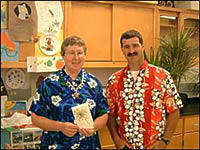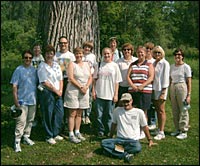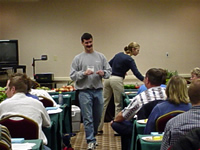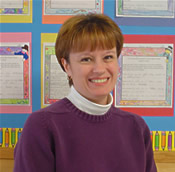
An electronic newsletter for the science education community
Field Notes
Educators share how they are using Project 2061 tools
This 2061 Connections report continues a series in which educators share—in their own words—how they are using AAAS Project 2061 reform tools to improve science and mathematics education.

- Gerber with Dr. Lucy Slinger, formerly in the University of Wisconsin-La Crosse School of Education, during a teacher workshop they led together.
Enhancing Botanical Education with Project 2061 Publications
As a faculty member of the Biology Department
at the University of Wisconsin-La Crosse (UW-L), I have worked with
in-service and pre-service K–12 teachers in my region for seven
years, with the goal of enhancing the botanical education of students.
My focus is to provide teachers with a better understanding of core
botanical concepts and to present classroom activities they can use
to better connect plants, in particular, and science, in general,
to the other subjects they may teach, whether art, literature, or
mathematics. This work is part of the Teachers
Using Living Plants (TULIP) Project, a botanical education initiative.
When I first started my preparation to give workshops, make presentations, and co-mentor projects with these practicing and future educators—many of whom are not biology majors—I turned to a variety of publications, one of which was Project 2061’s Benchmarks for Science Literacy. Benchmarks provided the general grade-level knowledge and concepts information I needed to address, to which I added the appropriate botanical concepts for my workshops and in-class activities. Through this process, an elementary-level plant curriculum was developed that has been added to the science curriculum of the School District of Onalaska, Wisconsin. Today I continue to work with teachers in this district to develop plant-related science activities for use in elementary classrooms.

- Gerber (sitting) with teachers from his local Onalaska, Wisconsin, school district during a field trip made as part of a summer workshop.
Here is one example of how I used Benchmarks and other AAAS-produced tools to develop a 3rd grade-level, plant-related classroom activity with Dr. Delores Heiden (UW-L Teacher Education), who wanted to integrate non-fiction science books into her literacy class. Pre-service teachers in Heiden’s class receive assignments with in-service teachers in my local school district. Ms. Kim Gavin, who teaches 3rd grade at Eagle Bluff Elementary in the Onalaska District, wanted help in designing a food-related lesson and wished to incorporate plants into the lesson activity.
After learning more specifics from Ms. Gavin, I assigned two pre-service teachers from Heiden’s class to look for more information on food preservation. In Benchmarks for Science Literacy, we identified one agriculture benchmark for grades 3 through 5 that was particularly relevant:
Heating, salting, smoking, drying, cooling, and airtight packaging are ways to slow down the spoiling of food by microscopic organisms. These methods make it possible for food to be stored for long intervals before being used. (See Benchmarks Chapter 8: The Designed World, agriculture benchmarks for grades 3 through 5)
I also directed them to the AAAS Science NetLinks Web site to check for related food preservation lessons. Meanwhile, I checked AAAS’s Science Books & Films for a related appropriate grade-level book and found How Do You Raise a Raisin? by Pam Munoz Ryan on its list of "Best Books for Children 2003."

- Gerber (center) running a “Grocery Store Botany” workshop for K–12 teachers during an NSTA-affiliated Wisconsin Society of Science Teachers annual meeting in 2004. Pre-service teacher Stefanie Lawniczak is helping.
Equipped with these resources, the pre-service teachers readied a presentation for a 3rd grade classroom, which included the distribution of raisins for snack-time. While these young students enjoyed the raisins, they read and talked about the How Do You Raise a Raisin? book, which had a lot of information on raisins and how they are produced. In another activity after snack-time, the students put grapes into a dehydrator and produced their own raisins for the very next day, which they also ate. Both the 3rd graders and the practicing teacher were thrilled with the activities, all of which were possible for the cost of some raisins and grapes, and a book and dehydrator.
I am planning a new activity for the classroom this year that includes the purchase of a grapevine so that 3rd graders can first experience harvesting the grapes before dehydrating them. Other fruits of the 3rd graders’ choosing will be dried this year to allow them to run some basic experiments and make comparisons about fruit drying times, and in this way present an inquiry-based model for the pre-service teachers to follow. This work establishes in the 3rd grade classroom what Project 2061 founder F. James Rutherford (1991) describes as “real science education,” while it also involves both a practicing teacher and pre-service teachers. For a minimal cost, we developed a science literacy lesson the children enjoyed, introduced pre-service teachers to Benchmarks and other user-friendly AAAS tools, and addressed some of the teacher education preparation and interdisciplinary connection challenges voiced by Rutherford and George Nelson (2005) and Iris Weiss (2005).
I have found Project 2061 publications valuable and I plan to continue promoting their use to teachers and local school district administrators. And as a botanist, a member of the Botanical Society of America, an affiliate society of AAAS, and a member of the AAAS itself, I also encourage my university colleagues to use these excellent tools developed by Project 2061.
Dr. Gerber is an associate professor in the Biology Department at the University of Wisconsin-La Crosse and director of the TULIP Project.

- Luan Sandberg
Improving Science Education in Quincy, Illinois
With the support of consultants Dr. Linda Brazdil
and Mary Ann Brearton, our committee of 40 teachers in kindergarten
through 12th grade worked to develop and strengthen our ability to
make sound educational decisions for the future of our science program.
As part of the three years that we worked to improve the quality of science
education in Quincy, Illinois, School District 172, we provided summer
in-service professional development that enhanced the district’s
opportunities for professional growth. A primary effort of the committee
was to sharpen the knowledge and skills essential for the evaluation
and review of our curriculum. To accomplish this goal, we learned
how to use Project 2061’s research-based tools, starting with Science
for All Americans and Benchmarks for Science Literacy.
The committee was first divided into smaller team units. Each team consisted of five or six teachers, in a variety of grade levels, who would read each chapter in Science for All Americans and Benchmarks for Science Literacy to prepare for discussing the instructional implications as well as the research-based student misconceptions. We then took a look at our existing curriculum and aligned the units that were currently being used with the learning goals that are recommended in Benchmarks. One result of this analysis was our realization that we were teaching an abstract unit on weather too early in the primary grades. We also used the growth-of-understanding maps in Atlas of Science Literacy, which helped us to discover that in several cases we were re-teaching topics. As a consequence, we were not able to advance student understanding and thus move ahead in the curriculum as far as we could have. This increased understanding of learning goals was constructive.

- Illinois teachers work in a team to evaluate their science curriculum during summer professional development.
All of our learning was used to create a database that helped us to keep track of our benchmarks, assessment frameworks, learning standards, instructional implications, and student misconceptions, as well as any additional helpful hints and suggestions for each unit. With this well-thought-out information, we were now ready to look for opportunities to strengthen and refine our science curriculum K–8. All of our work also helped us to discover one or two topics that were being missed completely and a few other topics that were over-taught. The full committee was also able to recommend ways to streamline the curriculum.
Once our suggested revised curriculum received approval, we began to examine science materials with a new emphasis placed on obtaining materials that would support the inquiry approach to teaching science. Once again, we used our Project 2061 documents to help us evaluate the materials we wanted to pilot. We were continually referring back to all of our resources.
We have been piloting our units with much success and have been receiving an overwhelmingly positive response from both the school administration and the public, who are praising what they believe to be a very methodical evaluation process. All of this work for science education only became possible because the Quincy Foundation for Quality Education and the Quincy Public Schools jointly funded it by raising money from grants, donations, and the public.
Reporting last January, the local newspaper, the Quincy Herald-Whig, wrote, “The Quincy School Board’s Curriculum Committee heard an update on a curriculum alignment process that is starting to show improvement in the district’s science scores” (read the full article). This work has been energizing, and as I told the Herald, “I can’t wait to see the growth we may make once we begin to implement it completely.”
Ms. Sandberg is a 3rd grade teacher at Washington School in Quincy, Illinois, and the science teacher leader for the district.



